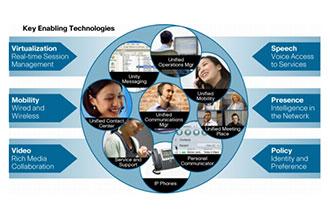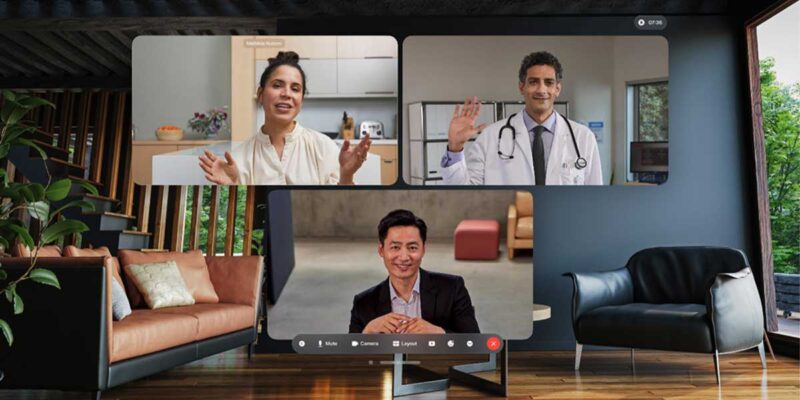InfoComm: Five Trends Changing Unified Communications
By Monica Heck
Special to InfoComm International
 Whether you call it simply unified communications (UC) or you also throw collaboration into the mix (UCC), it’s clear that this years-old-yet-bleeding-edge technology has finally gained its footing. Even if you struggle to define the collection of videoconferencing, chat, email and other solutions that fall under the UC umbrella, you know by now that customers are clamoring for them — and they need help.
Whether you call it simply unified communications (UC) or you also throw collaboration into the mix (UCC), it’s clear that this years-old-yet-bleeding-edge technology has finally gained its footing. Even if you struggle to define the collection of videoconferencing, chat, email and other solutions that fall under the UC umbrella, you know by now that customers are clamoring for them — and they need help.
“Everyone loves to throw the term UC around, but it’s really a disparate group of capabilities that are tied together by necessity, and the definition really varies,” says Alan Greenberg, senior analyst and partner at Wainhouse Research. “It can be a challenge to transition from legacy systems to a model that unifies presence, telephony, video, web conferencing, IM and active directory, and all the other services out there.”
And yet, in many respects, 2013 was a pivotal year for UC. “We are starting to see customers breaking down the silos of UC,” says Scott Cruikshank, director of converged communications at Dimension Data though. Here are five reasons why:
Trend 1: Video Rules
Finally, ubiquitous video is here. Part of the reason is technology; part is user acceptance. We can thank Skype, YouTube, Netflix and all those other online video services one might cringe to find in a commercial AV deployment. For industry expert Stephen Mulligan, video communication is the overnight success that’s been the “next big thing” for years.
“Travel budgets got squeezed and technology and bandwidth caught up to each other,” Mulligan says. “Crisp 1080p LED screens, video codecs, smart network-sensing technologies are all available at last.”
And don’t think Microsoft hasn’t noticed. The company that snapped up Skype jumped from desktop video and to rooms with the announcement of Lync Room System (LRS). “Depending on who you talk to, Lync Room System is either a spectacular success, generating a lot of demand, or it’s struggling,” says Greenberg. “Certainly, it has raised awareness of video being introduced into business processes and into the overall UC environment.”
David Danto, director of emerging technology for the IMCCA, the videoconferencing and telepresence industry association, says videoconferencing has enjoyed a business-to-consumer explosion this year. What was once a tool that companies used for themselves has become something they use to communicate with people outside their walls.
“Organizations that don’t want to be left behind need to communicate with their customers using tools they’re comfortable with,” Danto says. “Huge customer-facing organizations like Amazon and Fidelity Investments are saying they need UC tools to converse with their customers over video. That changes the game.”
Analysts contend that the little-noticed acquisition of cloud-based videoconferencing provider Vidtel by Fidelity Investments was for Fidelity’s own internal use — though Vidtel will continue to support existing contracts, according to Danto.
“But think about how that changes the market,” he says. “There’s one less player because a large wealthy financial services company felt it needed to take it off the market and use it for themselves.” A sure sign that video collaboration has made the big time.
Trend 2: Mobility
OJ Winge, CEO of Acano, a UC provider of virtual meeting rooms, cites mobility as one of the biggest trends this year. Increasingly, UC technology has migrated from fixed workstations toward mobile platforms outside the traditional office space. “It’s fueled by the consumerization of IT and by people bringing tools into the workplace that come from the private arena, like tablets and smart phones,” Winge says.
Danto says mobility and bring-your-own-device (BYOD) computing as part of an inevitable sea change. “The people who do not believe in more freedom are aging out of the market and using mobile technology as a scapegoat for bad management structure,” he says. “The companies that are succeeding are the ones that are creating reasonable mobile security policies.”
This, of course, puts pressure on IT administrators and requires coordination between IT and the AV professionals who best understand audio/video communication. “Technology managers can either support mobility for their users, or wake to find they’re use something they got free on the Internet,” Winge says. “Their challenge is to keep control over the employees, what tools are using, and where the information is going.”
Mobility and BYOD aren’t only about how people work when they’re away from the office. They are redefining how workers collaborate internally. Winge thinks, for instance, that the clock may be ticking on dedicated hardware in meeting rooms. “Why can’t I control a projector or a room from an iPad or a smart phone?” he says. “Why do I need cables and a special remote? Mobile UC is about recreating what’s in your pocket so users feel more comfortable using those tools.”
Trend 3: The Google Effect
You know the search giant couldn’t leave well enough alone. In 2011, Google released the source code for WebRTC, an application programming interface (API) for browser-to-browser UC, to the development community. In 2013, with mobility on the rise, WebRTC started to come into its own.
“It hasn’t been a year of massive deployment of WebRTC, but rather a year of adoption, experimentation and delivery,” says Greenberg. “Everyone knows it’s coming and that it will have an impact on the marketplace.”
Because WebRTC allows users to participate in a video call from a web browser, it requires neither a dedicated hardware device nor is a client application, such as Skype or Apple FaceTime. “It’s an alternative that allows people to make video calls — browser-to-browser or end point-to-end point — and still bridge those calls,” Greenberg says, “supported by service providers who support the connection of WebRTC calls to standards-based videoconferencing systems.”
Because WebRTC delivers non-proprietary video and voice straight to the browser, Mulligan sees it having an impact in both the consumer and the business markets. “Of course, room systems still have their place,” he says. “And you’re not going to use WebRTC in a 24-person conference room because it’s not going to scale. But it will have an impact over time.”
WebRTC could have a significant impact on UC and at call centers, according to Blair Pleasant, president and principal analyst at COMMfusion. “WebRTC will make it easier to do some of the things we’re doing now and open it up to more developers, meaning we’ll see more UC capabilities embedded into other applications.”
How big is WebRTC? Recently, Cisco announced a plan to open-source its H.264 codec, effectively making it free for use in WebRTC. “Part of supporting collaboration is lowering the cost of it, putting it in the hands of people, making it backwards compatible with investments people already have and making sure it’s done in a standards-based way,” says Chris Wiborg, director of marketing for Cisco Collaboration.
Trend 4: Increasing Clouds
The cloud has become the great equalizer in unified communications. Running UC software out on the Internet means that all a customer needs is a good network connection to enjoy all its benefits. “The cloud makes UC available to different types and sizes of organizations, rather than just the large organizations that can afford it,” says Pleasant.
But the cloud doesn’t mean clear skies (pardon the pun). Service providers need to come up with UC solutions that support various cloud deployments — private, public or hybrid clouds. “Initially, we’re seeing a higher interest in managed solutions in the cloud,” Cruikshank says. In other words, customers are asking service providers to manage their UC clouds, rather than building their own. “It shows that IT organizations realize that UC tools can place a burden on their teams,” Cruikshank says.
“A lot of folks we speak to want the best of both words,” says Cisco’s Wiborg. “A mix of services that leverages existing UC equipment on their premises and lowers the cost of participating in a cloud service.
Still, cloud-based UC is still in its infancy. Winge says the cloud is currently more of a testing environment than a large-scale deployment platform, based mainly on security and bandwidth concerns. The cloud certainly makes UC deployment easier, he says. “As companies get better at managing their cloud concerns, I’m a big believer in the move to cloud.”
Trend 5: The Adaptation of Pro AV
The evolution of UC poses both opportunities and threats to the pro AV world. On the one hand, advances in UC mean an increased demand for high-definition video delivered around the world. On the other hand, new UC solutions mean that many custom rooms are being replaced with rooms-in-a-box, and what might have been an obvious AV project before is falling under the purview of IT.
Companies such as Cisco are working with AV partners to understand how to use their video expertise. “From a channel perspective, we have to involve and cross-train them,” says Wiborg. “From a partner-margin perspective, we must make it attractive enough for them that they transition [to UC] make up some volume. Cisco has a huge installed base that hasn’t yet turned on video, and when they do, there’s an opportunity for partners in certain industries.”
Pleasant believes the uptake of video in UC is good news for pro AV. “The role of the integrator is increasing in value in terms of deploying UC systems and integrating them with the business processes,” he says. “As UC grows, the need for value-added resellers that deploy and customize these solutions is growing too.”
This column was reprinted with permission from InfoComm and originally appeared here.
Image via Cisco





